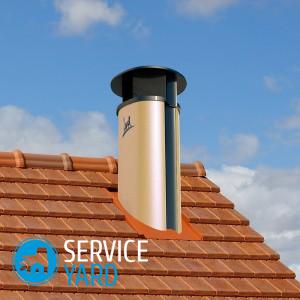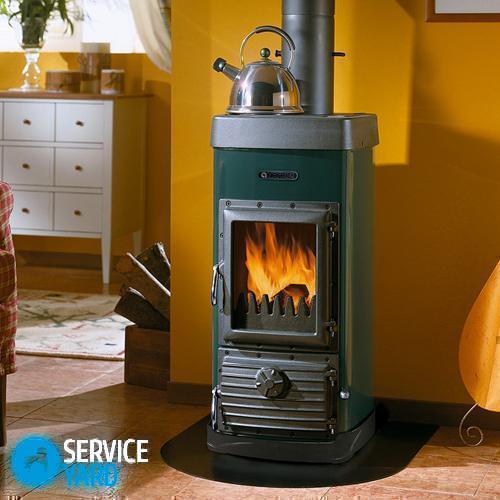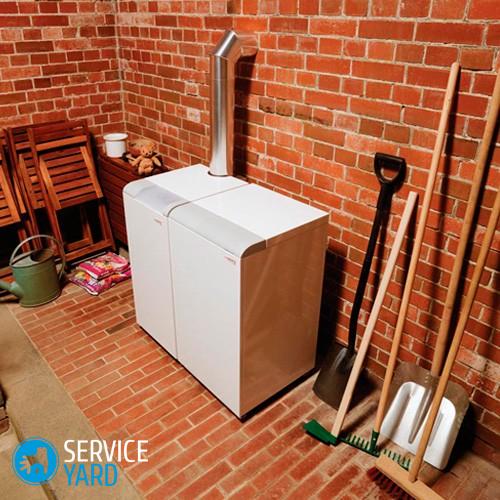DIY chimney sweeper

Owners of houses in which there are stoves rarely clean pipes - this is a fact. The owners of such houses begin to catch on when the draft in the furnace completely disappears and the smoke falls straight into the house or the rest room, it is also furnace in the bathhouse. As soon as this problem suddenly arises, you can run to the building materials store for a special device. But even if it is located half a step away from your home, this does not guarantee that you can immediately buy such a tool. Therefore, the question of whether it is possible to make a ruff for cleaning the chimney with your own hands is quite appropriate, and the correct answer to it is yes. How exactly to do this, you will learn from this article.
to contents ↑The easiest ruff to clean the chimney with your own hands
Today, everyone always has plastic bottles. It is they who will come in handy in this case. Ruff for a chimney from a plastic bottle is quite simple to manufacture, practically does not require additional financial costs, and cleans the pipes perfectly.
Additionally you will need:
- Heavy door handle, for example, made of brass. She will fulfill the role of a weight.
- The rope of the required length - find it in your household or buy in the department of household chemicals or in a hardware store.
To make a ruff for cleaning chimneys yourself, focus on the following recommendations:
- Use the top of the bottle, which you pre-cut to make some ribbons.
- For greater convenience of centering the load and threading the rope in the covers, drill holes using a drill.
- Tie the rope to the load and thread through the covers.
Important! During operation, it turns out that the upper and lower parts of the homemade brush will move relative to each other. Therefore, inside the ruff you will have to insert rings made from another plastic bottle. The rings that you cut, you need to cut and fit the diameter, and then fix them with an ordinary construction stapler.
- The rope that you tied to the load and passed through the lid must be pulled tightly and tied to a knot so that all parts of the brush are more tightly connected to each other.
to contents ↑Important! A brush for cleaning chimneys should turn out to be approximately 17.5-18 cm in diameter, with bottle tapes spread out in different directions. Unfortunately, a complete chimney coverage with this diameter cannot be made. Otherwise, if you make the diameter larger, dragging the brush across the pipe back and forth, up and down will be much harder because it will stop. But despite this, this situation can be corrected by simply making the load a little heavier.
The mechanical method of cleaning pipes
The profession of a chimney sweep is not so popular and in demand now, as in the recent past. In the twenty-first century, these specialists have become much smaller, and the cost of their services to customers is expensive. That is why owners of private houses more and more often have to clean the chimney with their own hands. Despite the fact that the process itself is not so complicated, it is necessary to approach its execution very responsibly.
Preparing the workplace for work.
Before using a ruff to clean the chimney, you must protect the premises from soot getting into it.To do this, close tightly all openings and hatches in the furnace through which soot can enter your room:
- In a conventional wood-fired oven, these are dampers.
- If we are talking about a fireplace, hang a firebox with a damp cloth, which, for greater reliability, fix along the perimeter with adhesive tape.
Important! According to the advice of experienced chimney sweeps, it is necessary to do such work during warm and calm weather, for example, in early autumn. But the choice of time of year is not a fundamental task, the main thing is the complete absence of wind. If you carry out work in windy weather, then you, as well as your neighbors, will receive a yard completely covered with soot.
Tool selection
If you nevertheless decided to buy a finished tool, and not make a ruff for cleaning the chimney with your own hands, choose the device that will meet the following requirements:
- The size of the device’s bristles must necessarily be 1-2 times larger than the diameter of the chimney.
- The brush material is an elastic steel wire or polymer materials that have appeared recently, successfully replacing metal.
- Devices that are used for rectangular and square pipes should be firmly and firmly fixed to a plastic or wooden holder. If there is such a need, it can be gradually increased, winding up new, additional segments.
Important! Square and rectangular chimneys that are heavily clogged are cleaned with special blades or scrapers. After this, the pipes are again cleaned with a brush.
Additional nuances of cleaning the chimney
In normal practice, they work with a brush that is suspended on a steel cable. In order for it to freely fall into the hole, hang a heavy object on it from below on a carbine, for example: a steel core.
Important! So that the core does not get stuck in the channel, it should be round, and its diameter should be approximately ⅔ from the pipe section. The core is used when foreign objects enter the chimney. Such items may include:
- bird's Nest;
- a brick that fell out of the wall.
to contents ↑In this case, the brush for cleaning the pipes is unfastened, the core is suspended from the cable and thrown into the channel. The knocked out jam, as a result, gets into the furnace. Then you can work with the main cleaning tool - a chimney brush purchased or made by your own hands.
What is the danger of a clogged chimney?
All that somehow relates to stove heating, are elements with increased danger. Therefore, there are such requirements:
- Based on fire safety rules, inspection of the system, including the chimney, should be carried out at least 2-3 times a year, especially during off-season periods.
- Preventive cleaning is recommended 1-2 times a year.
Frivolous about these rules and cautions is extremely unreasonable, because a “overgrown” chimney can lead to serious problems:
- A fireplace or stove can start to burn badly, as a result, the efficiency of cooking and heating is significantly reduced at the same cost of energy. Regular use of a ruff to clean the chimney will avoid this situation and cost overruns.
- Layers of soot that are caked can ignite under the influence of high temperatures. If these pieces of soot come off the inner wall of the chimney, they can fly out and set fire to the roof of the house, or other buildings nearby.
- In the chimney, which is covered with soot, the back draft effect often enough occurs. Carbon monoxide, as a result, penetrates into the premises. Its danger lies in the fact that it is odorless and colorless, so its detection is absolutely impossible. Typically, the stove is heated in the evening, so invisible carbon monoxide seeps into the room at night, while people are sleeping. It can cause poisoning and even death.
Important! Metal brushes for cleaning pipes, as well as other auxiliary items, are used when the soot layer in the chimney exceeds 2-3 centimeters.With small layers, they resort to dry cleaning or folk methods.
Process technology
Regardless of whether you decide to use a ruff to clean the chimney, made by yourself, or purchased, you must know the technology for its use. The process of cleaning pipes is very understandable even at an intuitive level:
- A pre-prepared device with a core attached from below descends into the chimney passage.
- By reciprocating movements the pipe is cleaned of accumulated soot.
- Upon completion of the work, through the technological shutters, the crumbling soot is removed.
Accessories manufacturers for effective soot management
If you bother with making a ruff to clean the chimney with your own hands, you don’t have a desire, and you decided to immediately purchase everything you need for proper care of the system, give preference to trusted manufacturers. So today are:
- Hansa is a Lithuanian company. This company has for many years been the first in the market of many CIS countries, as well as Europe. Chimney cleaners, hoses, fittings and plumbing and other accessories are present among the assortment of this brand. They are distinguished by their high quality and reliability.
- Sitecn - a manufacturer from Italy, which is known to many under the name “Kaminetti”. The assortment is wide, accessories of different diameters and different shapes, everyone will choose the perfect option for themselves.
- Biltema is a Swedish chain of stores. It is popular in Sweden itself, as well as in European countries. A wide selection, including universal brushes. The company offers its customers high reliability and quality of its products.
Why is the chimney clogging at all?
A closer examination of the design and principle of operation of the system will help to understand this issue. During the burning of firewood, gas is released and smoke is formed. White smoke comes from water vapor from wood, but black from coal, soot and creosote, from the same firewood. It is from black smoke that an unpleasant plaque is formed on the inner surface of the chimney. In addition, the rougher the surface, the more soot can settle on it.
A common cause of stove pollution can be the fact that many do not disdain to throw any garbage into the stove, such as: plastic bags, bags, bottles. It is strongly discouraged to do this, in order to facilitate the care of the chimney.
to contents ↑Stock footage
Be careful and attentive with your stoves and fireplaces, because they give you warmth and enjoyment on cool winter evenings. Clean the system on time and you are guaranteed security in your own home.
- How to choose a vacuum cleaner taking into account the characteristics of the house and coatings?
- What to look for when choosing a water delivery
- How to quickly create comfort at home - tips for housewives
- How to choose the perfect TV - useful tips
- What to look for when choosing blinds
- What should be running shoes?
- What useful things can you buy in a hardware store
- Iphone 11 pro max review
- Than iPhone is better than Android smartphones





